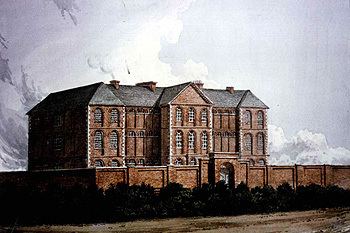Type Lunatic Asylum Town or city Bedford | Country England Architect John Wing Inaugurated 1812 | |
 | ||
Similar Fairfield Hospital - Bedfordshire, Three Counties railway st, Coronation Chair | ||
The Bedford Lunatic Asylum was built in 1812, and was the second of its kind in England. It was open for 48 years and closed in 1860 because the asylum was not improving its patients' health.
Contents
Map of Bedford Lunatic Asylum, Bedford, UK
Background
Before the Lunacy Act of 1808, only the rich could afford treatment for physical or mental ailments. Although the wealthy had money to pay for treatment, the techniques available at the time were neither safe nor humane. Purges, vomiting and restraint were standard treatments in an age which considered ‘raving madness’ and melancholia to be caused by physical malfunctions like any other disease." The passage of the Lunacy Act of 1808 allowed counties to build asylums with their own money. Changes started being made to help people with mental illness.
History
Samuel Whitbread was the mastermind behind the asylum. Whitbread concentrated on reforming the town after he failed to become successful in political office. Samuel Whitbread's true intentions with the asylum have always been debated. At the time, Bedford was a small town that needed many improvements, bridges needed to be restored and the town was lacking in industry. There is a question of whether his intentions were to help people, or to help himself and gain good publicity. Even so, in April 1812, the Bedford Lunatic Asylum, designed by John Wing, opened its doors. The asylum, however, did not fulfill the expectations of the people.
In 1845, thirty-three years after the opening of the asylum, the UK parliament created a new act stating that counties had to either build their own asylums or operate an asylum jointly with another county. Many other counties didn’t build asylums like Bedford, so there were now twice as many inmates in the asylum and not enough staff to help with their needs. Bedford’s neighboring counties, Hertfordshire and Huntingdonshire, then sent patients to Bedford. Soon after the three counties combined asylums in Fairfield Hospital near Arlesey, the Bedford Lunatic Asylum was shut down. It was seen as "unsuitable" for patients.
Medical treatments
Doctors, nurses, and others in the medical field still were ignorant about taking care of the mentally ill. This caused them to use harsh measures to help cure them. Straitjackets and handcuffs were the tools utilized most in the asylum. The attendants had much to do. Not only did they have to restrain the patients, but they also had to bathe them, dress them and help them through their daily exercises. The attendants understood that the patients were sick and should not be held accountable for the things they said and did. Doctors could not determine what would cure the patients, and choosing the type of doctor to treat the patients was also debated. If the lack of knowledge of how to care for the patients wasn’t enough, the asylum would run into other disastrous problems.
Renovation
The site of the asylum is now a residential building. As for the bodies of patients that died at the hospital, they are now buried underneath the children’s playground.
